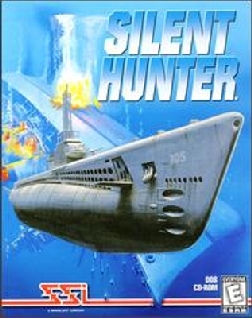Software:Silent Hunter
| Silent Hunter | |
|---|---|
 | |
| Developer(s) | Aeon Electronic Entertainment |
| Publisher(s) | Strategic Simulations |
| Producer(s) | Carl C. Norman |
| Designer(s) | William T. Becker Kim Biscoe |
| Programmer(s) | William T. Becker |
| Artist(s) | Kim Biscoe |
| Composer(s) | Doug Brandon |
| Platform(s) | MS-DOS |
| Release |
|
| Genre(s) | Submarine simulator |
| Mode(s) | Single player |
Silent Hunter is a World War II submarine combat simulation for MS-DOS, developed by Aeon Electronic Entertainment and published by Strategic Simulations in 1996. The game takes place in the Pacific War during World War II, the player commanding a submarine of the United States Navy. Most contemporary US submarines and Japanese warships are featured along with some generic merchant ships.
Gameplay
A single encounter generator is available, but the standard mode of play is the career mode, where the player must take their boat to patrol far behind enemy lines with the mission to search for and destroy any enemy shipping. For best success, the player should concentrate their search on shipping lanes, which may be deduced from contact reports. There are also special missions which may be assigned to a boat, such as beach reconnaissance involving photographing potential landing beaches through the periscope, and the rescue of downed airmen. Both missions were performed by the fleet submarines of World War II. The boat is actually commanded by crewing various stations in first person (no crew is visible, even though their voices are heard), which is common in the genre.
In career mode, the game begins when war against Japan is declared and continues through until August 15, 1945, when CINCPAC (Commander in Chief, Pacific Fleet) issues the order to cease all offensive operations against Japan. Success against the enemy rewards the Captain (the player) with medals as appropriate to the degree of success on a given patrol. However, there is a flip side to the game. One patrol without any sinkings will result in a verbal reprimand from COMSUBPAC (Commander, Submarines, Pacific Fleet). Two consecutive patrols with no sinkings will result in the Captain being relieved of command, as happened frequently in the Silent Service, particularly in the early days of the war. If a captain is relieved of command, the game is over. Also, it is possible for Japanese destroyers to sink a submarine by gunfire on the surface, or by depth charge attack while submerged. This also ends the game.
The submarines available in the game are the boats the United States Navy had during the war. They range from the ancient S-boats, and interwar boats like the Tambor class and Sargo class, to the later wartime Gato-class, Balao class, and Tench class subs. Technological advancements become available to the player at the same time in the game that the boats in the fleet got them. These include radar, the plan position indicator radar display, and the bathythermograph.
Weaponry similarly reflects what the boats had at any given point in the war. The torpedoes range from the Mark X used by the S-boats, to the Mark XIV steam torpedo and Mark XVIII electric torpedo, to the anti-escort "Cutie" acoustic homing torpedo. Deck guns, which are of minor value but have their uses, similarly range from three to five inch, again as the boats received them.
Reception
The game received "favorable" reviews according to video game review aggregator GameRankings.[1] Silent Hunter II developer Shawn Storc stated in an interview that Silent Hunter was a commercial success with 300,000 sold units.[8] By December 1999, global sales had reached 350,000 copies.[9]
Silent Hunter was nominated as Computer Games Strategy Plus's 1996 simulation of the year, although it lost to Jane's AH-64D Longbow.[10] The game was a finalist for Computer Gaming World's 1996 "Simulation Game of the Year" award,[11] which ultimately went to Jane's AH-64D Longbow.[12]
See also
- Silent Hunter II, sequel released in 2001.
- Silent Hunter III, sequel released in 2005.
- Silent Hunter 4, released in March 2007
- Silent Hunter 5, released in 2010
References
- ↑ Jump up to: 1.0 1.1 "Silent Hunter for PC". GameRankings. http://www.gamerankings.com/pc/198642-silent-hunter/index.html. Retrieved December 21, 2014.
- ↑ Wigmore, Glenn. "Silent Hunter - Review". AllGame. Archived from the original on November 15, 2014. https://web.archive.org/web/20141115090529/http://www.allgame.com/game.php?id=6059&tab=review. Retrieved December 21, 2014.
- ↑ Turner, Kevin (June 1996). "Run Silent, Run Deep (Silent Hunter Review)". Computer Gaming World (142): 78–80. http://www.cgwmuseum.org/galleries/issues/cgw_143.pdf. Retrieved April 24, 2016.
- ↑ Carnevale, Jason C. (October 1996). "Silent Hunter Review". Game Revolution. Archived from the original on February 10, 2001. https://web.archive.org/web/20010210014210/http://www.game-revolution.com/games/pc/sim/silenth.htm. Retrieved December 5, 2017.
- ↑ Mical, Kevin (May 30, 1996). "Silent Hunter Review". GameSpot. https://www.gamespot.com/reviews/silent-hunter-review/1900-2533001/. Retrieved December 21, 2014.
- ↑ McDonald, T. Liam (June 1996). "Silent Hunter". PC Gamer. Archived from the original on February 26, 2000. https://web.archive.org/web/20000226172028/http://www.pcgamer.com/reviews/946.html. Retrieved December 21, 2014.
- ↑ "PC Review: Silent Hunter". PC Zone. 1996.
- ↑ Special: Silent Hunter 2 - Interview on 4players.de "Das Original "Silent Hunter" hat sich über 300.000 Mal verkauft. Bei dieser Zahl war es für uns selbstverständlich, einen Nachfolger zu erschaffen." (2001, in German)
- ↑ PC PowerPlay staff (December 1999). "Spotlight: Silent Hunter II". PC PowerPlay (43): 24.
- ↑ CGM staff (March 25, 1997). "Computer Games Strategy Plus announces 1996 Awards". Computer Games Strategy Plus. Archived from the original on June 14, 1997. https://web.archive.org/web/19970614161401/http://www.cdmag.com/news/0325971.html. Retrieved November 2, 2010.
- ↑ CGW staff (April 1997). "Best of the Bunch: Finalists Named for CGW Premier Awards". Computer Gaming World (153): 28, 32. http://www.cgwmuseum.org/galleries/issues/cgw_153.pdf. Retrieved December 5, 2017.
- ↑ CGW staff (May 1997). "The Computer Gaming World 1997 Premier Awards". Computer Gaming World (154): 68–70, 72, 74, 76, 78, 80. http://www.cgwmuseum.org/galleries/issues/cgw_154.pdf. Retrieved December 5, 2017.

